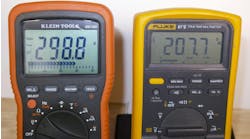With the rising popularity of residential and commercial landscape lighting, end-users and homeowners have begun looking for systems and components that combine easy installation and adequate safety considerations in one package. Standard 120V systems are unable to meet these requirements, so the industry’s landscape lighting manufacturers have responded by adopting 12V low-voltage systems as the standard for outdoor applications.
Low-voltage systems use smaller light sources, are easy to modify to accommodate changes in landscape layout, and are safer to operate and maintain than their 120V counterparts.
In standardizing the 12V low-voltage system, manufacturers have made available various sizes of step-down transformers to convert a standard 120V source to a 12V supply. The components of the system may be easier to work with, but voltage drop must be considered and understood to effectively service the customer’s landscape lighting needs.
Depending on its size and length, the conductor serving the fixtures of a low-voltage lighting system acts as a resistor. As current runs through the conductor, a voltage drop occurs: the voltage at the end of the conductor is lower than at the source. Smaller wires and higher currents will increase the voltage drop by raising resistance and increasing the fixture load respectively.
Why worry about it?
Voltage drop on a lighting circuit in a 120V system isn’t considered a major issue. The branch circuit currents are relatively low—usually 20A or below—and the standard wire sizes are usually large enough to minimize resistance problems. When working with 12V systems, however, the line current for any given load increases by a factor of 10. For example, a 100W 120V incandescent lamp draws .83A, but an equivalent load of two 50W MR16 12V lamps draws 8.3A. If you use the same size and length wire in both systems, the voltage drop in the 12V system will be 10 times greater than in the 120V system. In this case, voltage drop becomes a significant consideration.
When the actual voltage delivered to a given incandescent lamp is lower than the lamp’s rated voltage, the light output will be reduced. This relationship isn’t linear. When the voltage decreases to about 85% of its rated value, the visible light output is only about 50%. It continues to drop quickly from this point forward.
How to minimize voltage drop
Once you’ve finalized the lighting layout, you can control voltage drop by selecting the most effective gauge wire. The smaller the gauge, the less the voltage drop.
A minimum light output of 50% for the last fixture on a given run is normally an acceptable limit. Table 1 shows the maximum wattage allowed at various distances from a 12V transformer for various wire sizes.
You can use the information in Table 2 to identify the required wire size, length of straight run, and wattage load on a preselected value of light output at the end of any given cable.
Many transformers have multiple taps on the low-voltage side of the unit that provide 12V, 13V, and 14V output. Using a higher voltage tap to offset the expected voltage drop helps maintain the desired light output by delivering a closer-to-rated voltage at the remote lamps. This technique is used primarily where the distance to the first fixture is a long way from the transformer. Take care to avoid providing an over-voltage situation to the first grouping of fixtures, as this would shorten the lamps’ life.
You can also minimize voltage drop by altering your cable layout design. There are several options you can use other than a straight run:
-
Multiple straight runs can be made in several directions.
-
Tee connections reduce voltage drop by using heavier gage cable for the primary feed.
-
A loop design reduces voltage drop and allows the lighting units to give off a more uniform light output. It’s important to match the wire polarity at the transformer connection in a loop layout.
Locating several smaller transformers closer to the end of your cable runs can also help limit voltage drop. If at all possible, you should center the transformer in the run. If the light fixtures are located too far from the 120V source, consider running a 120V feed to a transformer located closer to the low-voltage lighting fixtures.
If you’re only trying to serve a few limited fixtures, consider using direct burial, 12V transformers for each fixture, which can be fed with a 120V source.
Another way to minimize voltage drop is to use lower voltage lamps in your design. For example, 18W lamps are the preferred choice for spread lights, but you can also use 12W lamps. If you do decide to use lower wattage lamps, however, recheck your photometric levels so you don’t wind up with an inferior lighting design.
Troubleshooting
Low-voltage lighting installations require a great deal of care during installation due to the high currents in the system. Placing too many fixtures on the circuit or using the wrong wire size can lead to a system overload. Therefore, it’s important to troubleshoot the system after installation.
The most common problems encountered in low-voltage landscape lighting installations are poor wire connections, too many fixtures on one transformer (overloading), and cables that are too small for the load.
By understanding voltage drop, you can address these problems and implement a successful low-voltage lighting design. Low-voltage lighting will allow the end-user to change the landscape layout and ensure safe outdoor lighting.
Liepold is a project management consultant for Progress Lighting in Spartanburg, S.C.



